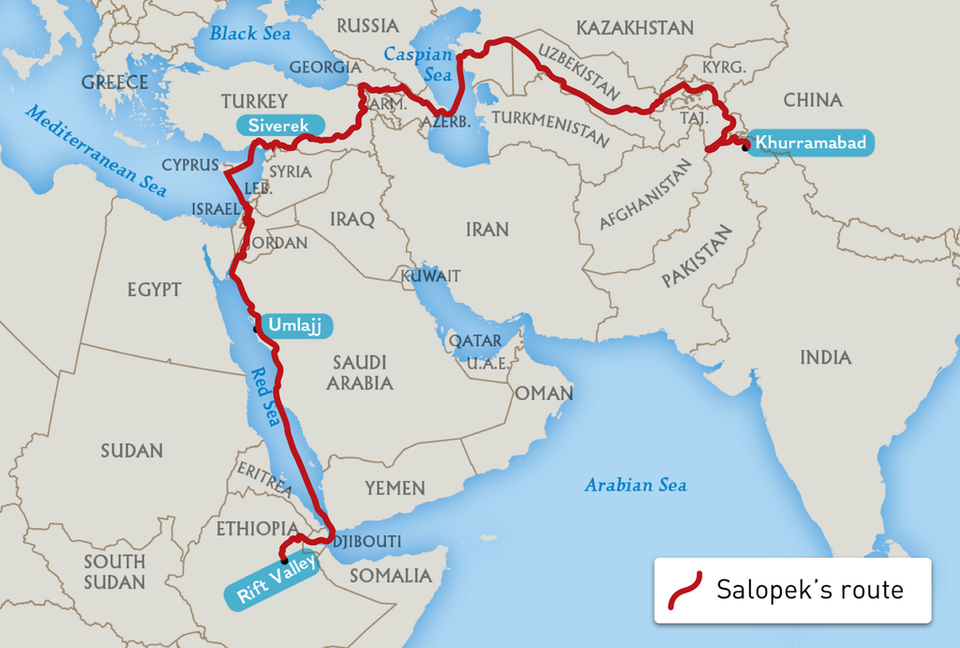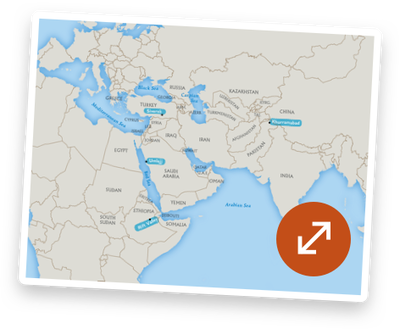

SoleBrothers
RiftValley,Ethiopia
January31,2013
Salopek’stripwillrequiremillionsofsteps,sohisfootwearisprettyimportant.InEthiopia,therearefew options.
Howdoyoumeasureaman?Lookathisshoes.Shoesannouncetheirwearer’sclass,style,evenjob.Itisdisorienting,then,tobewalkingthroughaplacewherehumanbeings—millionsuponmillionsofwomen,men,andchildren—sliponidentical-stylefootweareverymorning.Theyarethecheap,versatile,plasticsandalofEthiopia.Manypeoplearepoor,sotheybuyandwearwhattheycanafford.Povertydrivesdemand.Theonlybrandis necessity.
Acoupleofmycamelhandlersforthisportionofmyjourneyeachworematchinglime-greenplasticsandals.ThesurfaceoftheRiftValleyiscoveredinfootprintsstampedinthedustbymillionsoftheseplasticshoes.YetifEthiopia’spopularsandalsaremass-produced,theirwearersare not.Theydragtheirleftheel.Theyruintherightshoe’smoldingbysteppingonan ember.
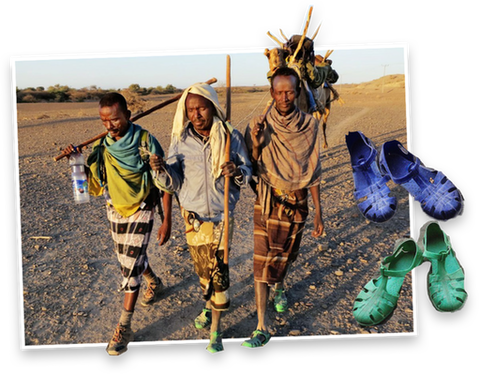
Ourguidekneltdowntheotherdayonthetrail,examiningtheshoes’endlessimpressions.Hepointedtoasinglesandaltrackandsaid,“La’adHoweniwillbewaitingforusinDalifagi.”Andsohe was.
MillionsofEthiopianswearthesamestyleofshoe,madefrommoldedplastic.
Awad’sRefrigerator
Umlajj,SaudiArabia
October30,2013
Salopekandhisguidesmustcarryeverythingtheyneedastheytrekfordaysandweeksatatime.Carryingwateracrossthedesertisessential.Butwhosaidanythingaboutitbeing cold?
Whenthefirst modern Homosapiens, ormodernpeople,walkedoutofAfricaandintotheArabianPeninsula,theregion’sseaswereloweranditshillsgreener.Thedetailsofwhatthesewanderersexperienced,wedonotknow.Whatisundeniablewastheirneedtocarry water.
Theweightofwaterisasensoryexperience.Waterisheavy.Itweighsfourkilograms(ninepounds)per3.8 liters(onegallon).Tocarryenoughofthisvitalsubstanceforgreatdistancesrequiresstrengthandingenuity.Whatdidthefirsthumanramblersuseascontainers?Nobodyknows.Canteensorbucketsmadeofnaturalmaterials?Perhapstheycarriedwaterinagurba—agoatskinwaterbladder.AwadOmran,mySudanesecamelhandler,hasasolutiontoconqueringtoday’sthirst.
Awad’scold-watercanteen:burlapricesack,cardboard,plastictwine,knife,needle,plasticwater bottle.
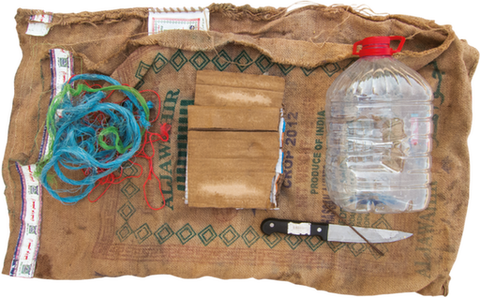
Omranspends20minutesbuildingawater-coolingthermos.It’smadeentirelyfromfoundmaterials—pilesofjunkdiscardedaroundafarm.Hewrapsalargewaterbottlewithcardboard.Hewrapsthecardboardbundleinpieceofburlapthatonceheldrice.Hemakesalonghandlefrom twine.
Awad’swaterrefrigeratoroperatesonthesimpleprincipleofevaporation.Wettedandhungonacamelsaddle,itsdampenedcardboardinsulationcoolsourdrinkingwaterbyseveraldegrees.Werefillit constantly.
Mule-ology
NearSiverek,Turkey
December11,2014
Salopekrarelytravelsalone.He’susuallyjoinedbyalocalguideandapackanimalortwotohelpcarrysupplies.Here,hewritesabouthismulewhiletravelingthroughTurkey.
Firstthingsfirst:Amuleisnotadonkey.Inmyopinion,adonkeyisamemberofthehorsefamilyburdenedbylowself-esteem.It’sasmall,modest,long-earedcreaturefromwhichmulesarebredwhenmatedwithahorse.Amuleissomethingelseentirely.Tocallamuleadonkeyisfighting words.
Therearejack mules(male)andjennyormollymules(female).Therearebluemules,cottonmules,sugarmules,andmining mules.
ButtheonethingI’velearnedisthatitdoesn’tmatterwhatyoucalla mule.Mulesdonottolerate names.
Ourwhitejenny,forexample,hasbeenbaptizeddifferentlybyeachofmywalkingpartnersacrossTurkey.OneguidecalledherBarbara,forreasonsonlyhecanexplain.AnotherdubbedherSunshine.StillanothercalledherSweetie.JohnStanmeyer,myphotographer,referstoheras Snowflake.
MypreferenceisKirkatir,aTurkishnamemeaning“greymule.”Thetruthisthat,likeallmules,sheanswerstonolabelhandedoutbyhumans.Kirkatirdoesnotcomewhencalledorwhenwhistledto.Shecomeswhenshefeelslikeit.Thisisnotveryoften.
Kirkatirdoeswhatshepleasesandwhenshepleases.Sheplodsalongatherownpace,shoulderingtheburdenofoursupplies.Andforthat,weare grateful.

PaulSalopek’smuleinTurkeymaynotcomewhencalled,butsheshouldersmuchoftheburdenonthewalk.
WalkingGrass
NearKhurramabad, Pakistan
January02,2018
Alonghistravels,Salopekencountersmanypeoplegoingabouttheirdailylives.Here,inPakistan,hecomesacrosssomefarmersharvestingandcarrying hay.
ThemountainrangethatcutsnorthernAfghanistanfromPakistanisacolddesert.Thereislittleprecipitation.
Foralltheirthickglaciersandsnowpack,thetoweringmountainsareparched.Inthelatesummers,glacialmeltstreamsdown,washingawayvillages,roads,and topsoil.
Thepeoplewhocallthisstarklandscapehome—manyofthemfarmers—readythemselvesforfall.Everyautumn,astheirpasturesdrytothecolorofgoldandcopper,villagersharvestwild hay.
Youcanseethemwalkingfasttoshortentheagonyundertheirheavyloads.Theylooklikehumanantstotinghuge bundles.
RehmanAliandBibiPariareoldernow.Theirsonshavegrownandmovedtolargercities.Buttheyremainandharvesttheirslopedandrockyfieldsbythemselves.Pari,thewife,standsnohigherthanmybicep.Hernamemeansfairy.” I canhardlybudgehercargo,butsherocksitswiftlytohershoulders.“Thankyou,brothers,”shesaystous,fortheridiculousactofwatchingher work.
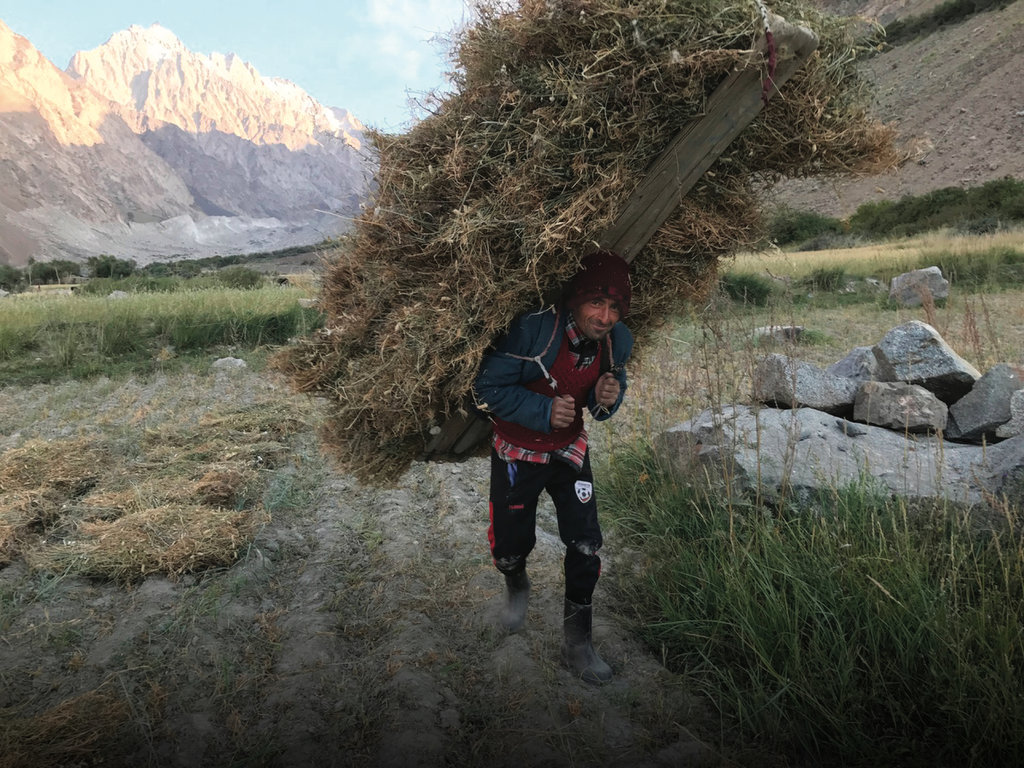
Afarmercarriesnearly45kilograms(one hundredpounds)ofhaytohishouseabout
3.2kilometers(two miles)away.
